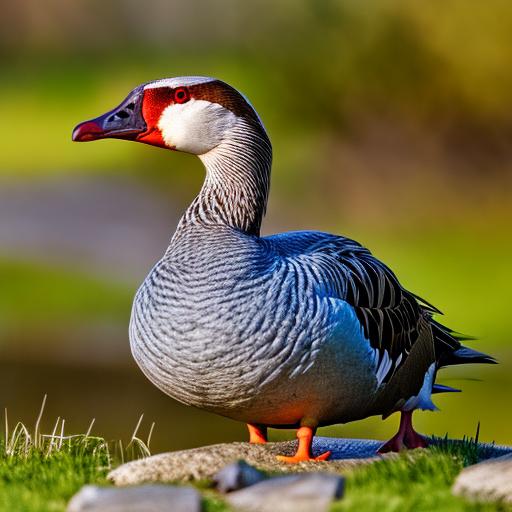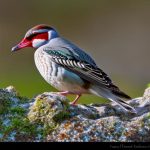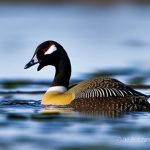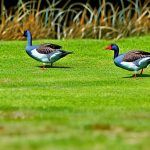Geese infestation is a common problem in many areas, causing damage to property and creating unsightly messes. Finding effective deterrents to keep geese away is essential for maintaining a clean and safe environment. In this post, we will discuss various methods that can be used to deter geese, including physical barriers, decoys, motion-activated deterrents, sound-based deterrents, scent-based deterrents, removing potential food sources, implementing landscaping techniques, encouraging natural predators, and seeking professional assistance.
Key Takeaways
- Geese are social animals and tend to return to the same location year after year.
- Physical barriers such as fences and netting can prevent geese from accessing certain areas.
- Decoys can be effective in deterring geese, especially if they are moved around frequently.
- Motion-activated deterrents such as sprinklers and lights can startle geese and discourage them from staying in an area.
- Sound-based deterrents such as loud noises or predator calls can also be effective in scaring geese away.
Understanding the behavior of geese
Geese are known for their stubbornness and persistence, which can make them difficult to deter. They are social animals that often travel in large flocks and have a strong sense of community. Geese are also territorial and will defend their nesting sites aggressively. Understanding these behaviors can help in choosing the right deterrents.
Creating physical barriers
Physical barriers are one of the most effective ways to keep geese away. There are several types of physical barriers that can be used, including fences, netting, and floating barriers. Fences should be at least three feet high and have small openings to prevent geese from squeezing through. Netting can be used to cover ponds or other bodies of water to prevent geese from landing. Floating barriers can be placed in water to create an obstacle for geese.
When installing physical barriers, it is important to ensure that they are properly maintained. Regular inspections should be conducted to check for any damage or gaps that may allow geese to enter. Additionally, it is important to remove any debris or vegetation that may accumulate around the barriers, as this can provide a landing spot for geese.
Using decoys to deter geese
Decoys can be an effective way to trick geese into thinking that an area is already occupied. There are various types of decoys available, including plastic replicas of geese, swans, or other waterfowl. It is important to choose decoys that are realistic and have natural movements to increase their effectiveness.
Decoys should be placed strategically around the area that needs to be protected. They can be placed on the ground, in the water, or on floating platforms. It is important to move the decoys regularly to prevent geese from becoming accustomed to their presence.
Installing motion-activated deterrents
Motion-activated deterrents are another effective method for keeping geese away. These devices use sensors to detect movement and emit a sound, light, or water spray to scare geese. The sudden and unexpected nature of these deterrents can startle geese and discourage them from returning.
There are various types of motion-activated deterrents available, including ultrasonic devices, strobe lights, and sprinklers. Ultrasonic devices emit high-frequency sounds that are unpleasant to geese but not audible to humans. Strobe lights create a flashing effect that can disorient geese. Sprinklers can be set up to spray water when motion is detected, creating a deterrent for geese.
Implementing sound-based deterrents

Sound-based deterrents can also be effective in scaring geese away. These devices emit loud noises or predator calls that mimic the sounds of natural predators. The sudden and unfamiliar sounds can startle geese and make them feel unsafe.
There are various types of sound-based deterrents available, including propane cannons, sonic devices, and predator calls. Propane cannons create loud bangs that mimic the sound of a gunshot. Sonic devices emit loud noises or predator calls at regular intervals. Predator calls can be recordings of natural predators such as coyotes or hawks.
Utilizing scent-based deterrents
Scent-based deterrents can be used to repel geese by creating an unpleasant smell that they associate with danger. There are various types of scent-based deterrents available, including chemical repellents and natural repellents.
Chemical repellents can be sprayed on the ground or vegetation to create a barrier that geese will avoid. Natural repellents can be made from ingredients such as garlic, chili peppers, or predator urine. These repellents can be sprayed or scattered around the area that needs to be protected.
Removing potential food sources
Geese are attracted to areas that provide a reliable food source. Removing potential food sources can help deter geese from an area. This includes removing any spilled birdseed, berries, or other food sources that may attract geese.
It is also important to keep garbage cans tightly sealed and clean up any food scraps or leftovers. Additionally, it is important to remove any standing water or puddles that may attract geese.
Implementing landscaping techniques
Landscaping techniques can be used to deter geese by making an area less attractive for nesting or feeding. This includes planting tall grasses or shrubs around ponds or other bodies of water to create a barrier that geese cannot easily navigate.
It is also important to trim grass and vegetation regularly to make it less appealing for geese to feed on. Additionally, installing rocks or gravel around the perimeter of an area can make it less attractive for geese to land.
Encouraging natural predators
Encouraging natural predators can be an effective way to keep geese away. Natural predators such as coyotes, foxes, or hawks can help control the goose population by preying on them.
To attract natural predators, it is important to create a habitat that is suitable for them. This includes providing shelter, food sources, and water sources that are attractive to these predators. It is also important to avoid using pesticides or other chemicals that may harm natural predators.
Seeking professional assistance
In some cases, it may be necessary to seek professional assistance in deterring geese. Professional wildlife control experts have the knowledge and experience to effectively deter geese and prevent future infestations.
When choosing a professional, it is important to research their qualifications and experience. It is also important to ask for references and read reviews from previous clients. Additionally, it is important to discuss the specific needs and concerns of the property with the professional to ensure that they can provide an effective solution.
In conclusion, there are various methods that can be used to deter geese and prevent infestations. These methods include creating physical barriers, using decoys, installing motion-activated deterrents, implementing sound-based deterrents, utilizing scent-based deterrents, removing potential food sources, implementing landscaping techniques, encouraging natural predators, and seeking professional assistance. It is important to try different methods and find what works best for each individual situation. By taking proactive measures to deter geese, property owners can maintain a clean and safe environment.
If you’re interested in learning more about geese and their behavior, you might find this article on “How Many Eggs Do Geese Lay?” from Poultry Wizard quite fascinating. It delves into the breeding habits of geese and provides valuable insights into their egg-laying capabilities. Understanding the reproductive patterns of geese can help you better comprehend their presence in your yard and devise effective strategies to keep them at bay. Check out the article here for a deeper understanding of these fascinating creatures.
FAQs
What are geese?
Geese are waterfowl birds that are commonly found in North America, Europe, and Asia.
Why do geese come into yards?
Geese may come into yards in search of food, water, or shelter. They may also be attracted to the grass and vegetation in the yard.
What problems can geese cause in yards?
Geese can cause damage to lawns and gardens, leave droppings that can be unsightly and unsanitary, and can be aggressive towards people and pets.
What are some ways to keep geese out of yards?
Some ways to keep geese out of yards include using physical barriers such as fences or netting, using decoys or scare tactics, and removing sources of food and water.
Are there any humane methods for keeping geese out of yards?
Yes, there are many humane methods for keeping geese out of yards, such as using noise makers, motion-activated sprinklers, and planting vegetation that geese do not like.
Is it legal to harm or kill geese?
In most cases, it is illegal to harm or kill geese without a permit. It is important to check with local laws and regulations before taking any action against geese.
Meet Walter, the feathered-friend fanatic of Florida! Nestled in the sunshine state, Walter struts through life with his feathered companions, clucking his way to happiness. With a coop that’s fancier than a five-star hotel, he’s the Don Juan of the chicken world. When he’s not teaching his hens to do the cha-cha, you’ll find him in a heated debate with his prized rooster, Sir Clucks-a-Lot. Walter’s poultry passion is no yolk; he’s the sunny-side-up guy you never knew you needed in your flock of friends!







